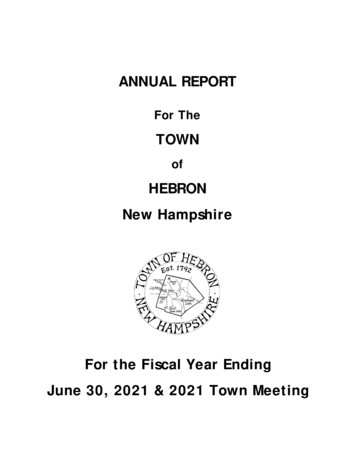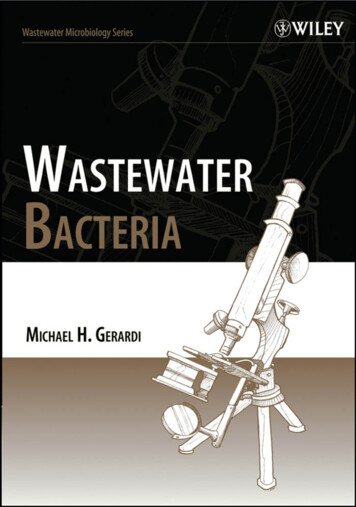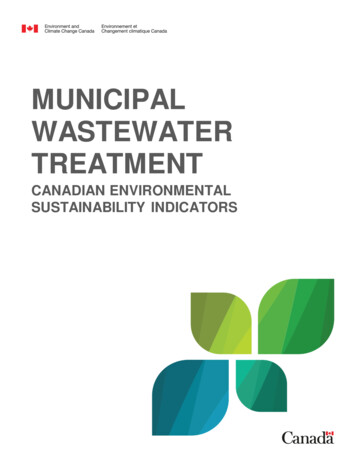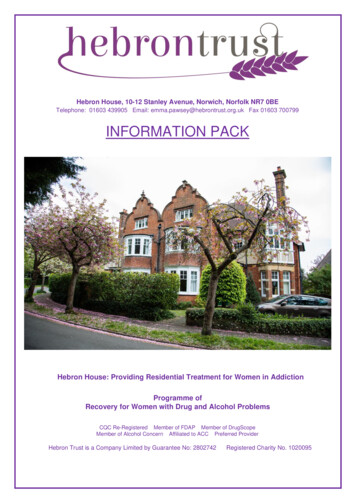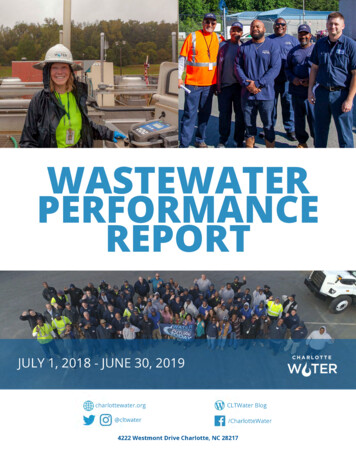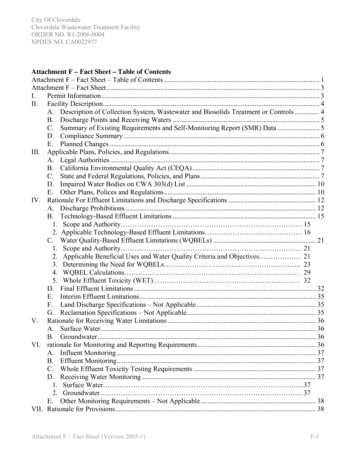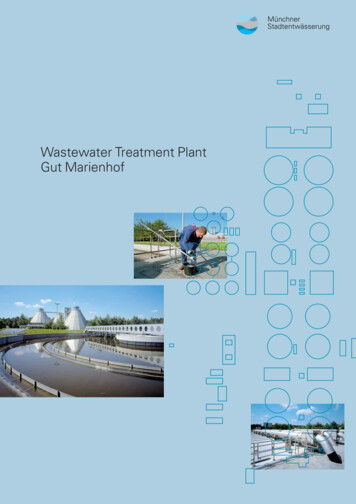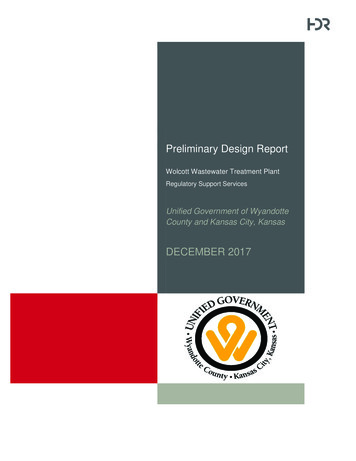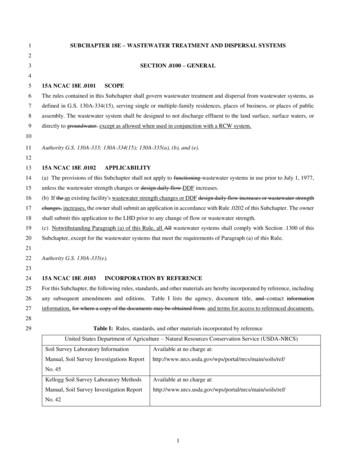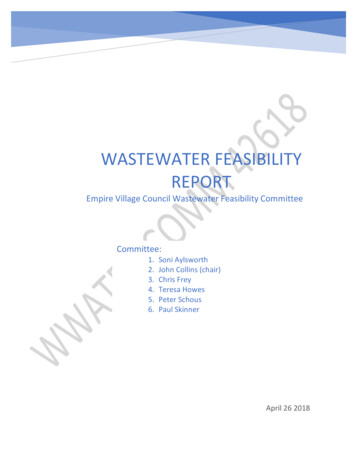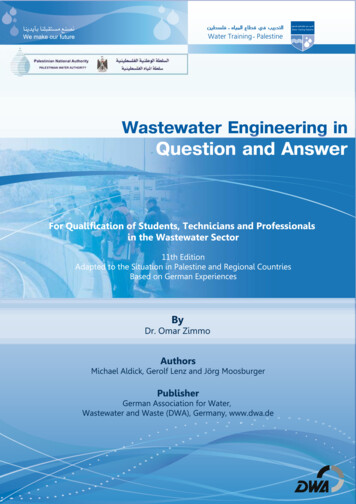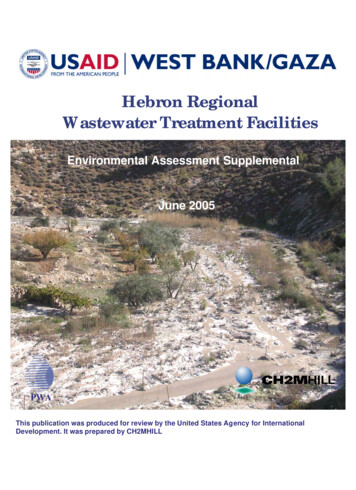
Transcription
Hebron RegionalWastewater Treatment FacilitiesEnvironmental Assessment SupplementalJune 2005PWAThis publication was produced for review by the United States Agency for InternationalDevelopment. It was prepared by CH2MHILL
Environmental Assessment SupplementalHebron Regional WastewaterTreatment FacilitiesPrepared forUSAIDJune 2005Jerusalem
Contents1.0Purpose.12.0Alternatives .32.1Project Description.32.2Environmental Impacts .52.2.1 Drinking Water Quality.52.2.2 Pesticides Use .52.2.3 Sludge and Bisolids Disposal.52.2.4 Gaseous Chlorine.62.2.5 Disposal of Wastewater Effluent.63.0Affected Environment.73.1Aquifer Systems.73.2Surface Water.134.0Environmental Consequences.144.1Drinking Water Quality.144.2Analytical Comparison.144.3Environmental Plan of Action.145.0References .16List of Preparers .17Figures2-13-13-23-33-43-54-1Hebron Wastewater Treatment Facilities Location MapHebron Wastewater Collection Systems and OutfallHebron Model Study AreaGeneral Geology and Formation OutcropsHydrostratigraphy of the Hebron AreaAl Rihiya Well to Bani Naim 2 Production WellAquifer Vulnerability MapAppendix A Scoping Statement and Record of Environmental DecisionENVIRONMENTAL ASSESSMENT SUPPLEMENTAL HRWWTFII
Acronyms and AbbreviationsACGIHBODCFRDOTEAEPAHRWWTFIPMm3 DWRP3WWTPAmerican Conference of Governmental Industrial HygienistsBiological Oxygen DemandCode of Federal RegulationU.S. Department of TransportationEnvironmental AssessmentU.S. Environmental Protection AgencyHebron Regional Wastewater Treatment FacilitiesIntegrated Pest Managementcubic meters per daymillion cubic metersPalestinian Ministry of Environmental Affairsmilligrams per literMinistry of PlanningNational Fire Protection AgencyNational Institute for Occupational Safety and HealthOccupational Safety and Health AdministrationPesticide Evaluation Report and Safe Use Action PlanPalestinian Water AuthorityTotal NitrogenTotal Suspended SolidsUnited States Agency for International DevelopmentWater Resources Program Phase IIIwastewater treatment plantENVIRONMENTAL ASSESSMENT SUPPLEMENTAL HRWWTF
1.0 PurposeThe United States Agency for International Development (USAID) has contracted withCH2M HILL to implement a master infrastructure planning project. The project is part ofthe Water Resources Program Phase III (WRP3) for the West Bank. CH2M HILL beganworking with the Palestinian Water Authority (PWA) on Phase II in January 1999 and onPhase III in July 2000.This contract is being implemented in close coordination with several organizations inthe West Bank, in particular the PWA, the Palestinian Ministry of Environmental Affairs(MEnA), the Hebron Governorate, and the Municipality of Hebron. Other agencies thathave provided expertise on an as-needed basis include the Palestinian Ministry ofAgriculture, Ministry of Planning and International Cooperation, and Ministry ofHealth.The WRP3 supports the development of the Palestinian water sector through completionof the following major elements: Integrated Water Resource Management PlanInstitutional Capacity BuildingImprovement of Environmental Infrastructure for the Hebron GovernorateDemonstration Options and ActivitiesTo support the Palestinian people and to improve the management of wastewater in anenvironmentally and sustainable manner, USAID has proposed the financing, design,and construction of a regional wastewater treatment plant in the Hebron Governorate.The environmental review requirements of USAID (22 Code of Federal Regulation [CFR]216) require the preparation of an Environmental Assessment (EA) for classes of actionsnormally having a significant effect on the environment, such as sewerage projects.In May 2003, an EA for the Stormwater, Domestic Wastewater Master Plan for Hebronwas completed. A Scoping Statement for a supplemental to the EnvironmentalAssessment was submitted in February 2005 to document a location change of theproposed Hebron Regional Wastewater Treatment Facilities (HRWWTF).The HRWWTF is proposed to be located in Wadi Es-Sammen, approximately7 kilometers northwest of the original location presented in the May 2003 EnvironmentalAssessment. The Scoping Statement and Record of Environmental Decision is attachedas Appendix A.A Record of Environmental Decision (ANE 05-89) was signed on April 1, 2005, by theANE Bureau Environmental Officer. The Decision stated:“The supplemental scoping statement for the EA of the WWTP is approved with these conditionsas considerations: If pesticides or chemicals designed to kill pests are to be procured or used, an IntegratedPest Management (IPM) plan may be prepared and an approved Pesticide EvaluationReport and Safe Use Action Plan (PERSUAP) must be developed and implemented.ENVIRONMENTAL ASSESSMENT SUPPLEMENTAL H RWWTF1
Proper disposal and potential use for generated sludge, such as alternative daily landfillcover, landscaping, composting, or other beneficial use, including testing of disposedbiosolids and composed material to assure that they meet appropriate screening criteriaespecially if application on edible crops is anticipated as highly effective biomasses oftencontain high levels of metals and other constituents unsuitable for edible crops. Potential safer alternatives to use of gaseous chlorine (an acutely hazardous substance),such as chlorine slurries or dissolved powders in liquids. Proper disposal and reuse of treated wastewater, including testing and assurance thatWWTP effluent disposed to or mixed with receiving waters containing aquatic life be dechlorinated prior to discharge or mixing to assure survival of chlorine-sensitive aquaticspecies.”ENVIRONMENTAL ASSESSMENT SUPPLEMENTAL HRWWTF
2.0 AlternativesThe report “Environmental Assessment for the Stormwater, Domestic WastewaterMaster Plan for Hebron” (CH2M HILL, May 2003) documented the project alternatives.The alternatives presented were to undertake a wastewater management program or toundertake “no action.” The EA concluded that the discharge of raw sewage to thenatural environment by the City of Hebron with a population of over 170,000represented a significant risk to the drinking water aquifer and to public health fromexposure to raw sewage.The selected HRWWTF project enables and integrates the goals of aquifer protection fora drinking water supply, reduced public health risk from exposure to raw sewage,development of an alternative agricultural water supply, expansion of agriculturaleconomic activities, and significant job creation.This supplemental to the EA addresses the proposed location change for the HRWWTF.The report “Addendum to the Detailed Feasibility of the Hebron Regional WastewaterTreatment Plant Reclaimed Wastewater and Residuals Management – Final”(CH2M HILL, April 2005) reviewed three alternative sites and documented the preferredsite. The preferred site is located in Wadi Es-Sammen, approximately 7 kilometersnorthwest of the original location presented in the EA.2.1 Project DescriptionThe report “Feasibility Study – Hebron Regional Wastewater Treatment Facilities”(CH2M HILL, May 2005) provides a detailed description of the proposed works andlocation. A summary of the project description is provided below.The Hebron site is located 4 kilometers south of Hebron City and 700 meters from thenearest residence. The site coordinates are 98,500 North, 160,000 East. The locationHRWWTF is shown on Figure 2-1.The site is located within a relatively flat area and flood plain in Wadi Es-Sammen. Theexisting land use of the site is as follows: 40 percent agricultural (olives, grapes, and subsidence winter wheat)30 percent damaged agricultural land due to flooding raw sewage flows30 percent rocky areasThe HRWWTF will be designed for the following flow and loading conditions: Annual Average Daily Flow 15,000 cubic meters per day (m3 /day) Biological Oxygen Demand (BOD5) Influent Average 930 milligrams per liter(mg/L); BOD5 Effluent Average 20 mg/L Total Suspended Solids (TSS) Influent Average 1008 mg/L; TSS Effluent Avg. 30 mg/L Total Nitrogen (TN) Influent Average 148 mg/L; TN Effluent Average 50 mg/LENVIRONMENTAL ASSESSMENT SUPPLEMENTAL HRWWTF3
DURAF:\Phase III\Task 12B\EA Supplemental\Dwg\fig 2-1.dwg, 5/31/2005 3:37:16 PMAL FAWARR.CAL REIHIYAHEBRONPROPOSED NEWWWTP SITEYATTASCREEN/ GRITSTATIONLEGEND :BANI NAIMWASTEWATER INFLUENT CONVEYANCE PIPERECLAIMED WASTEWATER CONVEYANCE PIPEFIGURE 2-1HEBRON WASTE WATER TREATMENT FACILITIESLOCATION MAP
The HRWWTF will include: Wastewater Influent Conveyance Pipe Wastewater Treatment Plant Preliminary Treatment Primary Treatment Secondary Treatment – Activated Sludge Disinfection (by liquid chlorine) Reclaimed Wastewater Storage (onsite) Sludge Drying Beds Biosolids Composting Reclaimed Wastewater Reuse Pipeline and System Storage2.2 Environmental ImpactsThe scope and significance of the environmental impacts stated in the Scoping Statementand Record of Environmental Decision are described below.2.2.1 Drinking Water QualityScope: The HRWWTF will reduce the pollutant inputs to the eastern and westernaquifers that are used as a drinking water supply for both Palestinians and Israelis.Significance: Currently raw wastewater is discharged into Wadi Es-Samen andpotentially could percolate into local shallow aquifers and into the deeper aquifer that isused for water supply. The proposed HRWWTF will greatly reduce the potential for rawwastewater and associated contaminants leaching to the aquifers by both providingtreatment of the raw wastewater and the use of the reclaimed wastewater on agriculturallands. Monitoring of the effluent quality is required under local regulations.2.2.2 Pesticides UseScope: The HRWWTF will not use pesticides or chemicals for management.Significance: If pesticides or chemicals designed to kill pests are to be procured or used,an Integrated Pest Management (IPM) plan may be prepared and an approved PesticideEvaluation Report and Safe Use Action Plan (PERSUAP) must be developed andimplemented.2.2.3 Sludge and Biosolids DisposalScope: The HRWWTF will generate a “Class A” biosolid after composting both primaryand secondary sludges. The “Class A” biosolid, as defined under local regulations, issuitable for application on agricultural lands as a soil amendment.Significance: Proper disposal and agricultural application of generated biosolids isrequired under local regulatory requirements. Monitoring of the biosolids quality isrequired to ensure compliance with regulations.ENVIRONMENTAL ASSESSMENT SUPPLEMENTAL HRWWTF
2.2.4 Gaseous ChlorineScope: The HRWWTF will not use gaseous chlorine. The effluent disinfection at theHRWWTF will be liquid chlorine based. Liquid chlorine will be produced onsite frompowder, tablets, salt, or sea brine.Significance: Gaseous chlorine is on the Hazardous Substance List because it isregulated by the Occupational Safety and Health Administration (OSHA) and cited byAmerican Conference of Governmental Industrial Hygienists (ACGIH), NationalInstitute for Occupational Safety and Health (NIOSH), U.S. Environmental ProtectionAgency (EPA), U.S. Department of Transportation (DOT), and National Fire ProtectionAgency (NFPA).2.2.5 Disposal of Wastewater EffluentScope: The HRWWTF will generate a treated and disinfected wastewater suitable foragricultural reuse as detailed in the report “Addendum to the Detailed Feasibility of theHebron Regional Wastewater Treatment Plant Reclaimed Wastewater and ResidualsManagement” (CH2M HILL, April 2005). The HRWWTF includes an onsite reclaimedeffluent storage facility, onsite pump station, agricultural reclaimed wastewater pipeline,and field storage. It will eliminate the discharge of untreated wastewater to the wadi.Surplus treated effluent will be discharged by gravity into the wadi for use byagriculture located downstream. There is no natural existing flow in the wadi. Theexisting dry weather flow in the wadi is untreated wastewater.Significance: Proper disposal and agricultural application of wastewater effluent isrequired under the local regulatory requirements. Monitoring of the wastewater effluentquality is required to ensure compliance with regulations.ENVIRONMENTAL ASSESSMENT SUPPLEMENTAL HRWWTF
3.0 Affected EnvironmentThe Scoping Statement and Record of Environmental Decision (Appendix A) haveidentified significant issues relating to the potentially affected environment. Thispotentially affected environment is the Aquifer Systems and Surface Water Systems.3.1 Aquifer SystemsAquifer systems in the Hebron area are considered vulnerable to pollution from surfacesources because the area constitutes a potential recharge area for the Upper and Loweraquifers. The discharge of raw sewage from the City of Hebron and surroundingcommunities therefore represent a risk to the continued use of the aquifers as a drinkingwater supply. Figure 3-1 shows the Hebron Wastewater Collection System and Outfallrelative to the Eastern and Western aquifers.A total existing annual water supply of 24 million cubic meters (MCM) per year has beenidentified to be at varying levels of risk due to the discharge of raw wastewater in thesouthern Hebron Governorate.The risk to both the eastern basin and western basin aquifer was detailed in the study“Groundwater Management Modeling, Task 7 – The Hebron Model” (CH2M HILL,March 2001) under WRP2. The drinking water wells at highest risk were identified asRihiya, Samu’a 1, Samu’a 2, Fawwar 1, and Fawwar 3 with a combined production ofapproximately 1.2 MCM. However, the groundwater modeling also identified a lowerpotential risk to Bani Naim 2 and Bani Naim 3 wells with a combined production ofapproximately 2.1 MCM. The groundwater sampling conducted under WRP2 indicatedthat the groundwater quality of Fawwar 1 and Fawwar 3 was above PalestinianDrinking Water Standards for nitrogen indicating contamination from either agriculturalor wastewater sources.The report “Conveyance, Treatment and Reuse of Hebron Wastewater” (Israeli Ministryof Infrastructure, January 2004) noted risk to the Shoqet and Ziqlag well groups with acombined production of 20 MCM. The same report also noted odor and mosquitoproblems for communities in the southern region of Israel.A groundwater model of the Hebron area was developed as part of Task 7 GroundwaterManagement Model – The Hebron Area, March 2001. The study area of the model isshown on Figure 3-2. The raw wastewater currently discharged from HebronMunicipality flows overland south down Wadi Es-Sammen. This overland flow islocated in potential recharge areas of both the Eastern and Western aquifers.Figure 3-3 shows the general geology and formation outcrops of the Eastern Basin.Figure 3-4 provides a general hydrostratigraphy of the Hebron Area. Figure 3-5 providesa hydrostratigraphic cross-section from Al Rihiya Well to Bani Naim 2 Well.ENVIRONMENTAL ASSESSMENT SUPPLEMENTAL HRWWTF
3.2 Surface WaterThe surface water is not considered vulnerable to environmental impacts from theHRWWTF due to the following factors: There is no natural groundwater flow in the wadi at the location of the proposedHRWWTF site. The existing flow in the wadi is untreated raw sewage discharged by the City ofHebron. There are no identified aquatic species living in the wadi at the proposed HRWWTFsite.The Hebron catchment area upstream of the proposed HRWWTF is approximately26 km2 . It is located on the western flank of a mountain range extending generally northto south through the West Bank. The Hebron catchment area drains south into the NahalBesor and Nahal Beka catchments that flow ultimately to the Mediterranean Sea. Thearea is characterized by exposed hard carbonate rocks with occasional colluvial mantel.There is limited vegetation. Channel beds tend to be gravelly.The Hebron catchment upstream of the proposed site includes both the City of Hebronand rural areas. The City of Hebron has areas of separated sanitary and storm sewers,combined storm and sanitary sewers, and unsewered areas. The existing systems aregenerally capable to convey the small major floods ( 5 year events). Medium majorfloods (5 year to 10 year events) and extreme events ( 10 year events) are conveyed bythe overland systems including the wadis.Due to the sewered areas in the catchment, urban runoff generally results from rainfallover 5 millimeters (mm). However, the rural areas, despite significant relief in the subcatchments, require larger rainfall events to generate runoff in the wadis.Five natural springs clustered in an area 3 to 5 km west of the HRWWTF site and withinthe catchment of Wadi Es-Sammen: En Noqar, Kenar El Gharbiyeh, Kenar EshSharqiyeh, Abu Kheet, El Majnooneh, and Dilbeh. However, these springs are utilizedfor local uses and do not contribute to the flow to the wadi.There is no natural dry weather flow in wadi Es-Sammen at the HRWWTF location. Thewadi has an existing flow of untreated raw sewage of approximately 5,000 to6,000 m3 /day generated by the City of Hebron. During wet weather events, thecombined raw sewage and rainfall runoff overflow the existing dry weather channel inthe wadi and flow over and pond on adjacent agricultural areas. As a consequence ofthis flooding, approximately 30 percent of the selected site for the HRWWTF is damagedagricultural lands.ENVIRONMENTAL ASSESSMENT SUPPLEMENTAL HRWWTF
4.0 Environmental Consequences4.1 Drinking Water QualityThe HRWWTF will reduce the pollutant inputs to the Eastern and Western aquifers thatare used as a drinking water supply for both Palestinians and Israelis, as described in theprevious sections and Section 4.2.This reduction in pollutants will be achieved by: Construction and operation of the HRWWTF to treat raw wastewater currentlydischarged to the environment of Wadi Es-Sammen. Construction of a reclaimed wastewater system to distribute the treated wastewaterfor use in the agricultural community. This limits the discharge of treatedwastewater to the environment.The environmental consequences of constructing and operating the HRWWTF arelargely positive. The remaining adverse environmental effects that cannot be avoided areaddressed in Section 4.3.4.2 Analytical ComparisonFigure 4-1 shows the results of the groundwater model for the Hebron area. The modelpredicts that the flow in the shallow aquifer at the location of the HRWWTF will be tothe east. However, further downstream in Wadi Es-Sammen both the shallow and deepaquifers will be to the west. Therefore, the existing risk of groundwater contamination isto both to the upper and lower Eastern and Western aquifers.Therefore, treatment of the existing raw sewage discharged to the environment fromHebron Municipality will greatly reduce the risk to the upper and lower aquifers.In addition, a further protection to the aquifer will be through the operation of areclaimed wastewater system. The distribution of the treated effluent to agriculturalusers will minimize the potential for its infiltration to the aquifer. The planned reclaimedwastewater program is described in the report “Addendum to the Detailed FeasibilityStudy of the Hebron Regional Wastewater and Residuals Management, Final”(CH2M HILL, April 2005).4.3 Environmental Plan of ActionThe following elements comprise the Environmental Plan of Action for each projectelement, as applicable: The use of pesticides is not part of the planned works. Only liquid chlorine is anticipated to be used. No chlorine gas will be used as part ofthe planned works. Effective utility personnel protection from risks of liquid chlorineuse should include the following, or equivalent, measures at the treatment plant: Since liquid chlorine is not commonly used in the West Bank, operations staffwould need training and maintenance guidance. A training program forENVIRONMENTAL ASSESSMENT SUPPLEMENTAL HRWWTF14
treatment plant workers on the handling, characteristics, and risks of its use hasbeen included in the Contract Documents. Because liquid chlorine is highly corrosive, storage of liquid chlorine would needto be far away from corrodible materials. Since liquid chlorine can also producechlorine gas if stored near ferric chloride, storage of liquid chlorine would needto be separate from ferric chloride. Project detailed design (plans andspecifications) and operations and maintenance manuals should reflect the needto keep these chemicals separate from each other. The tender and contract documents include provisions informing contractors of theirenvironmental responsibilities for dust, erosion, and noise abatement; minimizationof traffic disruption, adherence to street repaving requirements, maintaining accessto dwellings, schools and mosques, and movement of emergency service providers;identification of potential hazardous materials risks; mitigation for groundwaterpollution; and coordination with utility providers. Before construction begins and periodically during construction, contractors willconsult with Ministry of Planning (MOP) concerning proposed construction. TheHebron office of the MOP will be contacted to determine the appropriate measuresfor notification of the MOP during construction. Prior to completion of construction, staff training on safe chemical use, handling andstorage is to be initiated. Traffic and Access. Residents and owners of buildings on affected streets must benotified at least 1 week in advance of construction. The onset and duration ofconstruction, what to expect, and a contact name, address and phone number forquestions and complaints must be communicated. Project construction will be coordinated with the local governments. To minimize erosion and siltation during construction, piles of spoil and fill will becovered and removed daily. A comprehensive program of public awarness and a participatory approach in thefinal design of the reclaimed wastewater system should be part of the programimplementation. Local landowners, community leaders, and other interested partiesshould be identified and contacted concerning the project details. Project benefits andimpacts should be communicated to elicit comments and concerns regarding projectimplementation. Results of the public awarness program should be used to guideproject development in harmony with community concerns and interests. Training is required for agricultural water users prior to operation of the reclaimedwastewater system.ENVIRONMENTAL ASSESSMENT SUPPLEMENTAL HRWWTF
5.0 ReferencesCH2M HILL. 2001. Groundwater Management Modelling, Task 7 – The Hebron Model,March.CH2M HILL. 2001. Hebron Wastewater Monitoring Program Task 6 – Final Report, JuneCH2M HILL. 2001. Task 8 Stormwater, Domestic Wastewater, and IndustrialWastewater Master Plan for Hebron, July.CH2M HILL. 2001. Task 9 Hebron Governorate Wastewater Treatment Feasibility Study,November.CH2M HILL. 2002. Addendum to Wastewater Treatment Feasibility Study, March.CH2M HILL. 2002. Task 3 Draft Integrated Water Resources Management Plan, May.CH2M HILL. 2002. Task 10 Hebron Industrial Wastewater Control and Pre-TreatmentFeasibility Study, May.CH2M HILL. 2003. Detailed Feasibility Study of Reclaimed Wastewater and ResidualsManagement for the Hebron Regional Wastewater Treatment Plant, May.CH2M HILL. 2003. Task 17 Environmental Assessmemnt for Stormwater, DomesticWastewater Master Plan for Hebron Task 8, and Feasibility Study Analysis Task 9, May.CH2M HILL. 2003. Completion Report - Demonstration Projects, Reclaimed WastewaterReuse, Biosolids Composting and Reuse, September.CH2M HILL. 2004. Completion Report - Industrial Demonstration Projects Stone CuttingLiquid and Solid Waste Treatment. March.CH2M HILL. 2004. Completion Report - Industrial Demonstration Projects TanneryChromium Removal and Recovery Facility. March.CH2M HILL. 2005. Addendum to the Detailed Feasibility Study of the WastewaterTreatment Plant Reclaimed Wastewater and Residuals Management, April.CH2M HILL. 2005. Scoping statement for the Environmental Assessment of the HebronRegional Wastewater Treatment Plant, February.CH2M HILL. 2005. Hebron Screen and Grit Station, Volume II Technical Specificationsand Volume III Drawings.CH2M HILL. 2005. Request for Proposal – USAID RFP 294-2005-001, Design/ BuildSubmittal Procedure, May.CH2M HILL. 2005. Hebron Regional Wastewater Treatment Facilities, Feasibilty Study,May.CH2M HILL. 2005. Supplemental for the Environmental Assessment of the HebronRegional Waste Water Treatment Facilities, May.Israeli Ministry of Infrastructure, 2004. Conveyance, Treatment and Reuse of HebronWastewater. January.ENVIRONMENTAL ASSESSMENT SUPPLEMENTAL HRWWTF16
List of PreparersJim Ruhl, USAID CTOBlair Bevan, CH2M HILL Task ManagerBelal Elayyan, CH2M HILL Project EngineerMustafa Nusseibeh (Task 7 – The Hebron Model Hydrogeological Background Report),CH2M HILL HydrogeologistENVIRONMENTAL ASSESSMENT SUPPLEMENTAL HRWWTF17
Appendix AScoping Statement and Record of Environmental Decision
The report "Feasibility Study - Hebron Regional Wastewater Treatment Facilities" (CH2M HILL, May 2005) provides a detailed description of the proposed works and location. A summary of the project description is provided below. The Hebron site is located 4 kilometers south of Hebron City and 700 meters from the nearest residence.
